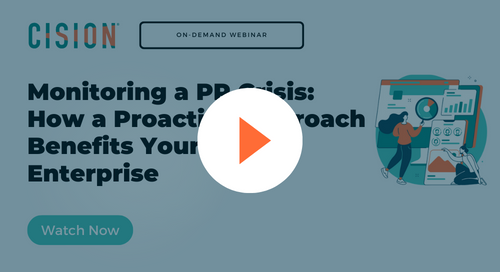The most effective strategic communicators, brand managers, and publicity executives know that a proactive approach to media monitoring is key to staying ahead of any potential crisis.
It’s always best to remain informed and act pre-emptively so as not to have to take a defensive position in the public sphere or have a situation spin out of control.
Public relations crises can be costly reputationally and financially, and no one wants to see companies and institutions they’re committed impacted negatively on their watch.
Many of the increasingly complex challenges faced by communications professionals are rooted in rapid and systemic shifts in media: an accelerated news cycle, the constant shift of multiple social media, and the loss of a single source of truth in the public sphere.
Though every organization should have a solid crisis plan in place that includes identifies who is on point for what, there are ways to see around the corner before a situation becomes out of control.
Technology and human intelligence can better empower companies and brands to stay ahead of and stave off a potential crisis. By employing real-time monitoring of authoritative news outlets and social media channels, PR professionals are less likely be caught off-guard.
What Is Media Monitoring?
In the context of public relations, media monitoring is the collection and analysis of news coverage and content posted to public-facing social media accounts. By scanning multimedia content for keywords and phrases, and layering in density, context, and other facets, media monitoring tools can surface conversations as they begin to trend, identify consumer sentiment (positive, neutral, negative), and track stories and breaking news in real time.
The best solutions will include access to relevant news and editorial content published online, in print, via broadcast and podcasts, and even from sources that sit behind paywalls. They provide baseline data from which a potential crisis will make itself known. In the world of PR, early detection is everything.
Benefits of Media Monitoring
Oftentimes when a PR crisis occurs, there is a shortage of two critical elements: time and information.
When it comes to a potential brand issue, comms teams should be the first to know about it. Strategic communication teams know that it’s far better to surface the possibility of a negative situation and not be called out unaware.
With early detection in place, comms teams can be more proactive, more agile and better equipped to formulate a rapid but thoughtful response and prevent a PR crisis in the making.
Not only does media monitoring alert users of potential issues before they reach a critical stage, if one knows where specific conversations are gaining traction, one is better positioned to know where and how to respond.
Media monitoring also provides insights into the words and phrases that matter, as well as views of velocity and audience. Information isn’t just power – it can be the difference between a minor issue and a full-blown crisis.
Part of strategic communications plan, media monitoring allows for mitigation of reputational threats, the ability to generate clear reports to key stakeholders, and visibility into when a crisis can be considered over.
In-depth media analysis may also bring new opportunities to the fore, in terms of audience development, future partnerships, tailoring messaging and social media platform investment. And with access to real-time and historic data, PR teams are able to see the impact of their work and understand the influence of outlets they’re reaching in their own campaigns.
More Expert Insight on Media Monitoring for Crisis Comms
Hear from Cision Insights experts Mollee Jakubisin, Associate Director, and Julien Barrientos, Senior Analyst, how media monitoring adds value before, during and after a crisis in the on-demand webinar, Monitoring a PR Crisis: How a Proactive Approach Benefits Your Whole Enterprise.
